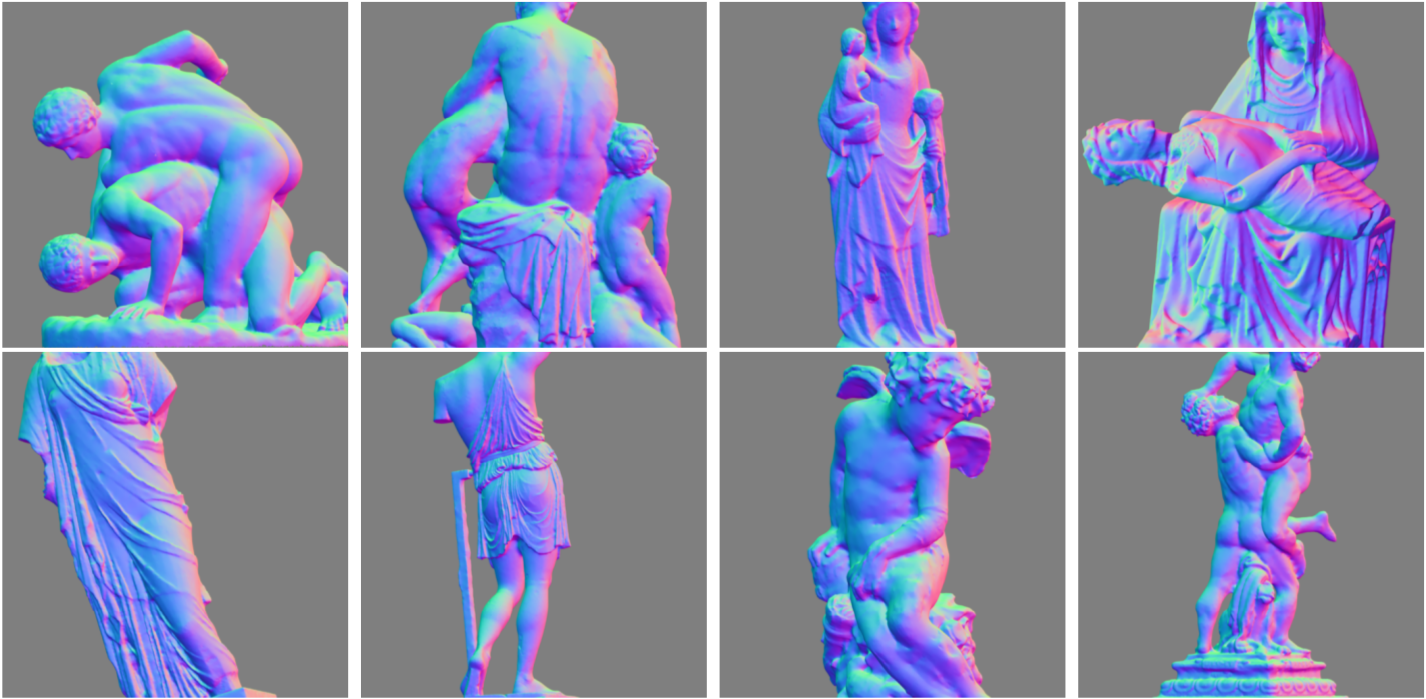guanyingc / Ps Fcn
Programming Languages
Projects that are alternatives of or similar to Ps Fcn
PS-FCN
PS-FCN: A Flexible Learning Framework for Photometric Stereo, ECCV 2018,
Guanying Chen, Kai Han, Kwan-Yee K. Wong
This paper addresses the problem of learning based photometric stereo for non-Lambertian surface.
Changelog
- June 25, 2020: We have updated the code to support applying data normalization for handling surface with SVBRDFs, as introduced in the journal version of this work.
- July 27, 2019: We have already updated the code to support Python 3.7 + PyTorch 1.10. To run the previous version (Python 2.7 + PyTorch 0.40), please checkout to
python2.7branch first (e.g.,git checkout python2.7).
Dependencies
PS-FCN is implemented in PyTorch and tested with Ubuntu 14.04, please install PyTorch first following the official instruction.
- Python 3.7
- PyTorch (version = 1.10)
- numpy
- scipy
- CUDA-9.0
Overview
We provide:
- Datasets: Blobby dataset (4.7 GB), Sculpture dataset (19 GB)
- Trained models (on both the Blobby dataset and the Sculpture dataset with a per-sample input number of 32):
- PS-FCN for calibrated photometric stereo
- UPS-FCN for uncalibrated photometric stereo
- Code to test on DiLiGenT main dataset
- Code to train a new model
Testing
Download the trained models
sh scripts/download_pretrained_models.sh
# You can find the downloaded model in ./data/models/
If the above command is not working, please manually download the trained models from Google Drive (PS-FCN and UPS-FCN) and put them in ./data/models/.
Test on the DiLiGenT main dataset
# Download DiLiGenT main dataset
sh scripts/prepare_diligent_dataset.sh
# Test PS-FCN on DiLiGenT main dataset using all of the 96 image-light pairs
CUDA_VISIBLE_DEVICES=0 python eval/run_model.py --retrain data/models/PS-FCN_B_S_32.pth.tar --in_img_num 96
# You can find the results in data/Training/run_model/
# Test UPS-FCN on DiLiGenT main dataset only using images as input
CUDA_VISIBLE_DEVICES=0 python eval/run_model.py --retrain data/models/UPS-FCN_B_S_32.pth.tar --in_img_num 96 --in_light
Training
To train a new PS-FCN model, please follow the following steps:
Download the training data
# The total size of the zipped synthetic datasets is 4.7+19=23.7 GB
# and it takes some times to download and unzip the datasets.
sh scripts/download_synthetic_datasets.sh
If the above command is not working, please manually download the training datasets from Google Drive (PS Sculpture Dataset and PS Blobby Dataset) and put them in ./data/datasets/.
Train PS-FCN and UPS-FCN
# Train PS-FCN on both synthetic datasets using 32 images-light pairs
CUDA_VISIBLE_DEVICES=0 python main.py --concat_data --in_img_num 32
# Train UPS-FCN on both synthetic datasets using 32 images
CUDA_VISIBLE_DEVICES=0 python main.py --concat_data --in_img_num 32 --in_light --item uncalib
# Please refer to options/base_opt.py and options/train_opt.py for more options
# You can find checkpoints and results in data/Training/
Data Normalization for Handling SVBRDFs (TPAMI 2020)
Download the trained models
sh scripts/download_pretrained_TPAMI_models.sh
# You can find the downloaded model in ./data/models/
If the above command is not working, please manually download the trained model from Google Drive (PS-FCN_normalize) and put it in ./data/models/.
Test on the DiLiGenT main dataset
CUDA_VISIBLE_DEVICES=0 python eval/run_model.py --retrain data/models/PS-FCN_B_S_32_normalize.pth.tar --in_img_num 96 --normalize --train_img_num 32
# You can find the results in data/Training/run_model
Training
CUDA_VISIBLE_DEVICES=0 python main.py --concat_data --in_img_num 32 --normalize --item normalize
# You can find checkpoints and results in data/Training/normalize
FAQ
Q1: How to test PS-FCN on other dataset?
- You have to implement a customized Dataset class to load your data. Please refer to
datasets/DiLiGenT_data.pyfor an example that loads the DiLiGenT main dataset. Precomputed results on DiLiGenT main/test dataset, Gourd&Apple dataset, Light Stage Dataset and Synthetic Test dataset are available upon request.
Q2: Which eight sculpture shapes were used in rendering the training datasets? Why?
- Normal maps of the eight selected sculpture shapes are shown in the below figure (filenames can be found in this link). We chose these 8 shapes for their high quality meshes and complex geometry. Other complex 3D objects can also be used.
Q3: What should I do if I have problem in running your code?
- Please create an issue if you encounter errors when trying to run the code. Please also feel free to submit a bug report.
Q4: Where can I download the Gourd&Apple dataset and Light Stage Data Gallery used in the paper?
- Gourd&Apple dataset is introduced in the paper [Photometric stereo with non-parametric and spatially-varying reflectance, Alldrin et al., CVPR 2008]. You may try to download this dataset from Alldrin's homepage. However, it seems that this link is not working now. You may send an email to the authors for this dataset. You can download the Light Stage Data Gallery from http://vgl.ict.usc.edu/Data/LightStage/. To test PS-FCN on these two datasets, please first preprocess and reorganize the images in a way similar to DiLiGent benchmark.
Citation
If you find this code or the provided data useful in your research, please consider cite:
@inproceedings{chen2018ps,
title={{PS-FCN}: A Flexible Learning Framework for Photometric Stereo},
author={Chen, Guanying and Han, Kai and Wong, Kwan-Yee K.},
booktitle={ECCV},
year={2018}
}
@article{chen2020deepps,
title={Deep Photometric Stereo for Non-{Lambertian} Surfaces},
author={Chen, Guanying and Han, Kai and Shi, Boxin and Matsushita, Yasuyuki and Wong, Kwan-Yee K.},
journal={TPAMI},
year={2020},
}



